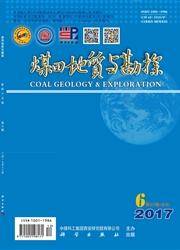

 中文摘要:
中文摘要:
为研究鄂尔多斯盆地东缘石炭–二叠纪古气候特征及其与成煤作用之间的关系,利用X射线衍射(XRD)及扫描电子显微镜(SEM)对研究区石炭–二叠系泥质岩中的黏土矿物组成及其环境意义进行分析。结果显示,区内泥质岩中黏土矿物主要以高岭石、伊利石/蒙皂石混层矿物为主,次为伊利石和绿泥石。黏土矿物的垂向组合特征表现为:高岭石在桥头剖面、扒楼沟剖面和成家庄剖面山西组,桥头剖面太原组底部、成家庄剖面太原组上部及本溪组中部含量偏高。伊利石在各个剖面的山西组中含量较高,绿泥石仅在山西组中上部、太原组下部含量较高。扫描电镜下黏土矿物晶体形态规则,未见明显磨蚀痕迹,伊利石结晶度为0.42°Δ2θ~0.63°Δ2θ,平均值为0.47°Δ2θ,结晶度较好,混层比相对质量分数平均值25.1%,表现为自生黏土矿物。根据自生黏土矿物的习性指出研究区古气候总体表现为温暖潮湿、间或在太原组早期和山西组中—晚期伴有短周期干冷气候。古气候与沉积环境两者相互印证指示聚煤作用强度的变化过程,是控制研究区内聚煤作用的关键因素。
 英文摘要:
英文摘要:
In order to study the paleoclimatic characteristics of the Carboniferous-Permian and its relationship with coal formation in eastern margin of Ordos basin,XRD diffraction analysis and SEM methods are used to study the composition of clay minerals and its geological significance.The results show that the mixed layer of kaolinite,illite and smectite are the major clay minerals in argillaceous rock,followed by illite and chlorite.The vertical distribution of clay minerals in argillaceous rock reflects that kaolinite in Shanxi Formation of Qiaotou section,Palougou section,upper of Chengjiazhuang section has high content.And the bottom of Taiyuan Formation of Qiaotou section,the upper of Taiyuan Formation and the middle of Benxi Formation in Chengjiazhuang section have high content of kaolinite too.Illite has high content in Shanxi Formation of each section.Chlorite has higher content in the middle and the upper of Shanxi Formation and lower content in Taiyuan Formation.Under the SEM,clay minerals are in regular shape and do not have obvious erosion marks.Illite crystallinity is0.42°Δ2θ~0.63°Δ2θ,with an average of0.47°Δ2θ,which has good crystallization,I/S interstratified ratio has an average value of25.1%.According to the characteristics of authigenic clay minerals,the overall paleoclimate was warm and humid,short-term dry-cold climate existed in early Taiyuan Formation and middle-late Shanxi Formation.Paleoclimate and sedimentary environments reflected mutually the change process of coal accumulation,and are the key factors to control coal accumulation in the study area.
 同期刊论文项目
同期刊论文项目
 同项目期刊论文
同项目期刊论文
 期刊信息
期刊信息
